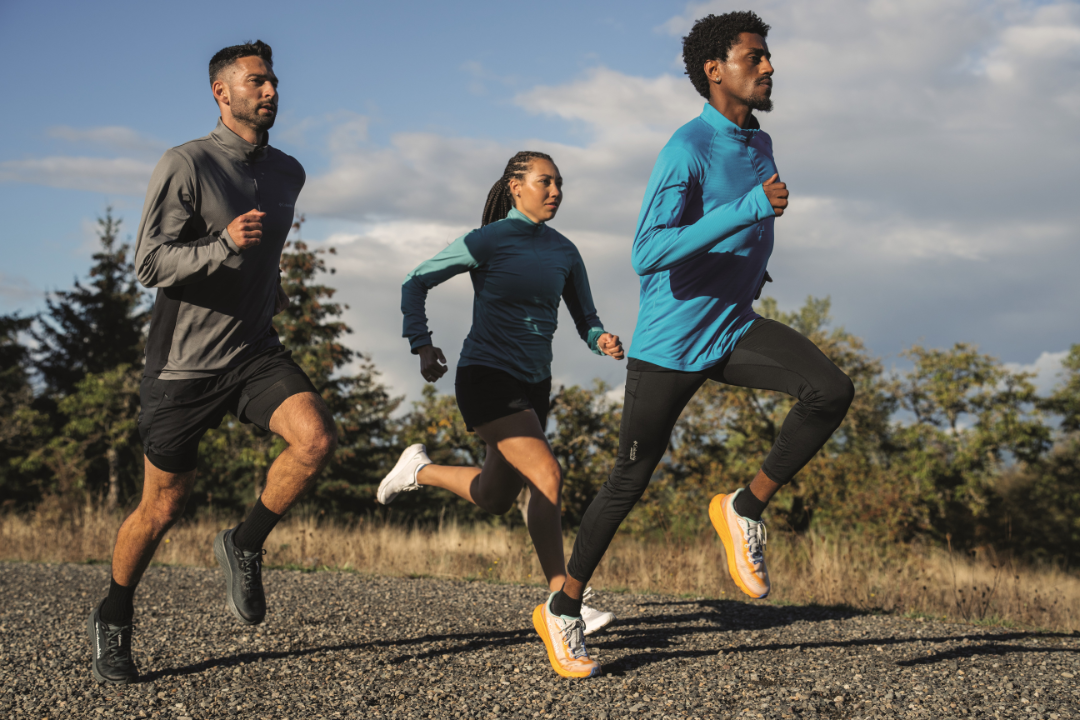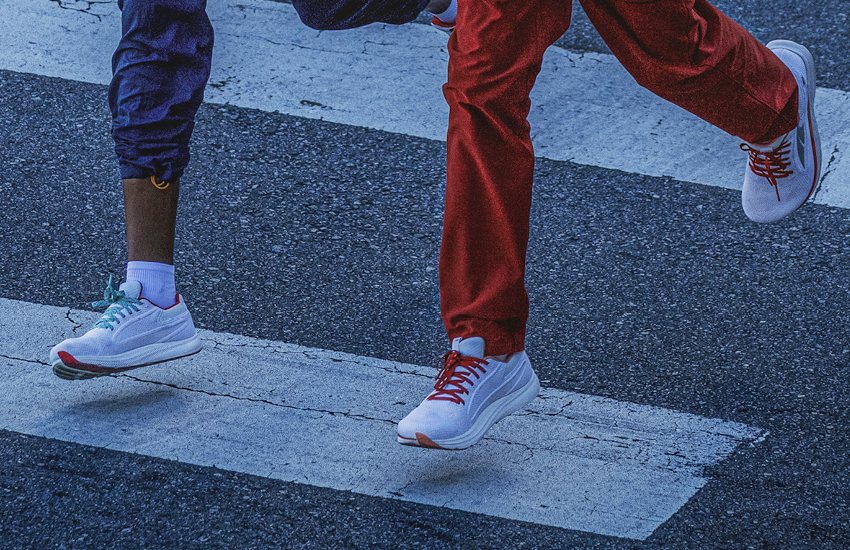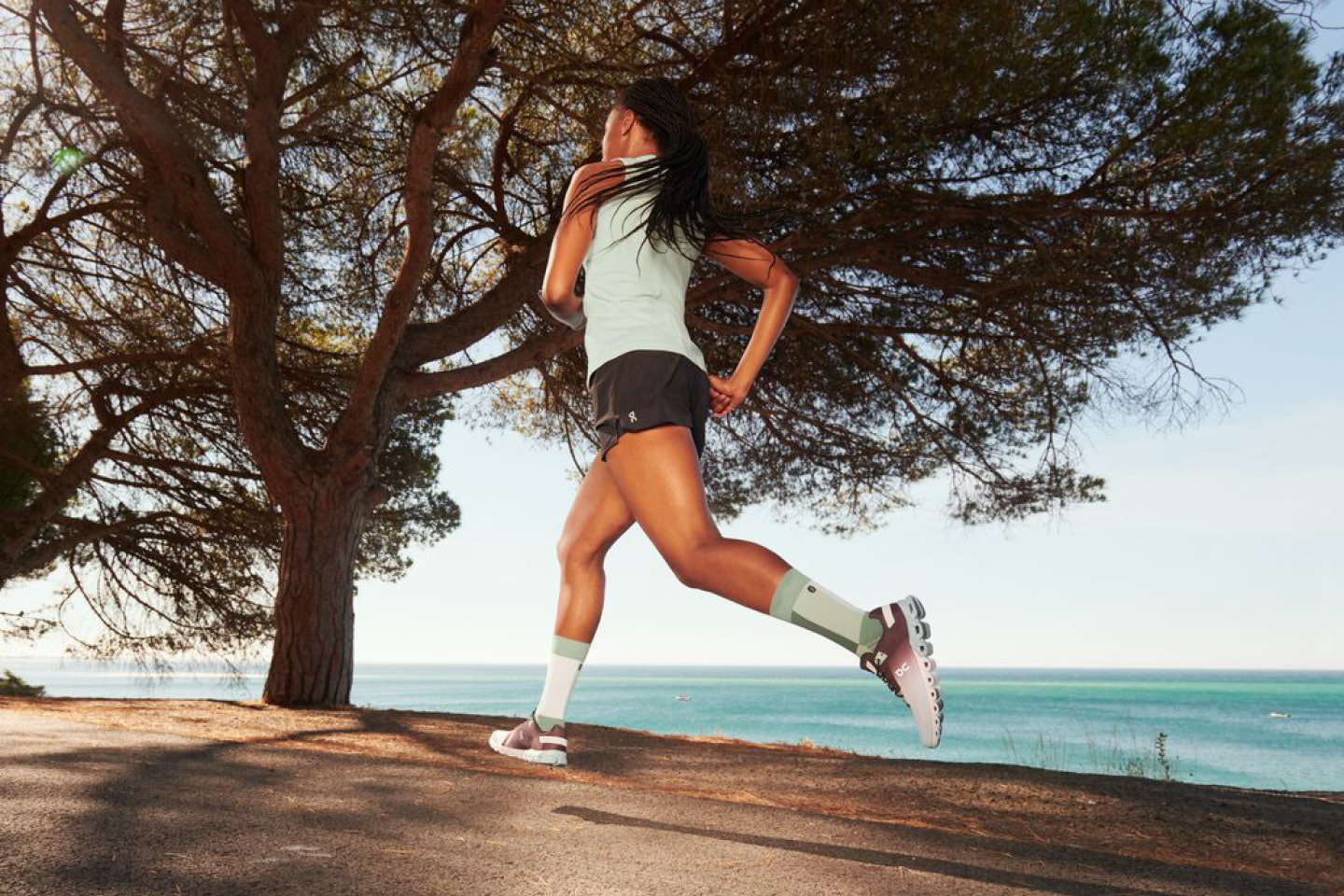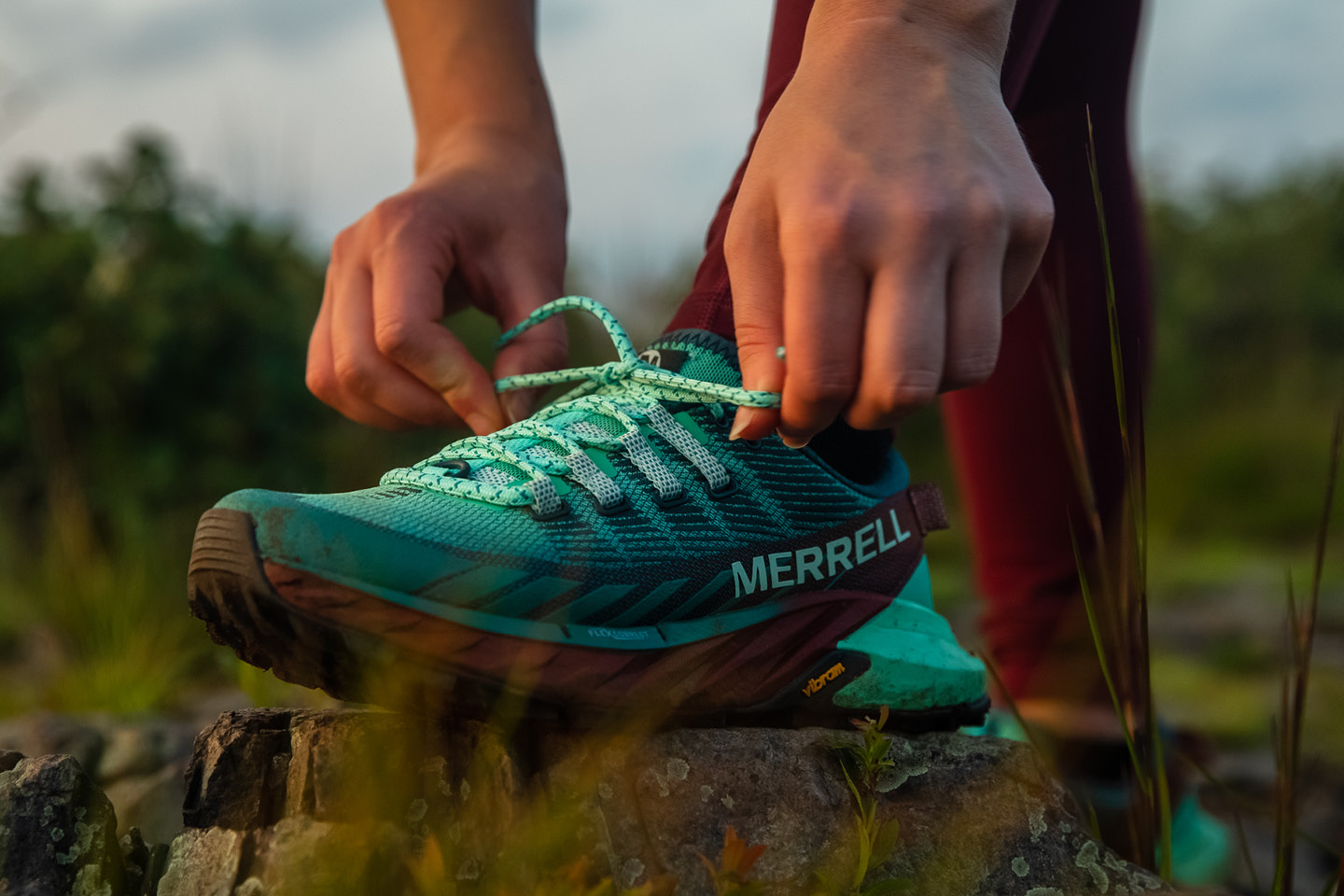Planning a Trek in Andalusia
Outdoor Activities | April 3, 2025
SAIL
March 12, 2025

Running doesn’t require much equipment, but a good pair of running shoes is indispensable. What makes “good” running shoes? In short, the fact that they are tailored to your running style, performance level, and goals. It doesn’t matter if you are just starting out or attempting to progress to the pro level; you need shoes that fit you just right and help you make the most of every run. Now choosing those can get confusing – between the technical jargon and the countless running shoe models available for men and women. But it doesn’t have to be so complicated. The key is knowing where to look: running shoe type, cushioning, drop, support… Let’s go over the criteria to help you find the ultimate pair of shoes that will keep you running for kilometres.
In this article, you will learn more about the criteria to consider when choosing a pair of running shoes:

Where do you like to run? This is an excellent question to begin with because the answer will guide you towards a specific type of running shoes.
If you’re inclined to quiet trails in the woods, rocky mountain tracks, or scenic gravel roads, go for a good pair of trail running shoes. If you’re more of a pavement-pounding type and prefer running on asphalted roads, choose road running shoes specifically designed for that purpose. Maybe you’re not sure, or you would rather have the ability to switch from one terrain to another. In that case, look for more versatile running shoe models – or better yet, get two pairs!
Road running shoes are made to absorb repeated impacts on asphalt. They combine a lightweight, breathable upper with a foam midsole that usually has ample cushioning. Shoes built for the roads are more flexible, lighter and less sturdy than their trail running counterparts.
Most models are versatile and adapted to virtually every type of recreational run; light jogging, active recovery, long outings… Others are more “technical” and work especially well for fast-paced runs, intervals and competitions (such is the case for carbon-plated running shoes, for instance).
With trail running shoes, you can tackle any terrain and elevation level – no rocks, mud, roots, or any other obstacle can stop you when you’re properly geared up.
Running shoes made for the trails have lugs on their outsoles to provide optimal grip on steep, wet or rugged terrain. Stiff and durable, they are usually built with a rock plate inside to protect feet from sharp rocks and branches. Their uppers are constructed to resist abrasion and have optimal shock absorption – some models also feature a waterproof upper, which is very convenient if you run in the winter.
Like road running shoes, there are trail shoes for various uses. Some lightweight, dynamic models are geared toward “short” to medium distances under 50 km, while others are more comfort- and support-oriented for wear during longer runs and ultra-trails.
If you own a pair of multi-sport shoes, you can certainly wear them to run a few kilometres around your neighbourhood. As you start running more frequently (or if your plan from the get-go is to train several times a week), you should consider getting some “real” running shoes. Their impact on your health and the pleasure you get from running is worth it.
This cannot be overstated: multi-sport shoes are not well suited for running. Aside from increasing the risk of injury, they create discomfort and unpleasant running sensations on roads and trails. If you want to do your muscles and joints well, it’s best to choose a pair that was specifically designed for running.

How much cushioning, flexibility or dynamism you need from running shoes is a matter of preference and use. Some novice and recreational runners prefer a high level of cushioning, even if that means a slight loss in dynamism. Performance-oriented runners tend to lean towards more reactive shoes, especially for “tempo” runs and interval sessions. Having multiple pairs with different sets of qualities is helpful as you can use them in a rotation, depending on your training sessions.
Cushioning is a running shoe’s capacity to absorb the impact of your stride. Good cushioning is recommended for daily runs, slower paces and recovery jogs. It is less of an issue for trail running, as the ground’s natural cushioning allows you to turn to shoes that are a bit more dynamic.
Flexibility in a men’s or women’s running shoe is the criterion of choice for anyone looking for comfort or wanting to improve the “quality” of their feet from a running perspective. Stiffer shoes generally provide better support and greater dynamism.
As for the dynamism of a shoe, it is a function of several components, such as the type of foam used for the midsole and the presence of a nylon or carbon plate. Dynamism is especially important if you want to break your records on race days.
There are two main approaches when it comes to running shoes: “minimalist” shoes and “maximalist” shoes. The choice of one or the other has an impact on the amount of mechanical stress your body undergoes when you run.
In short, maximalist shoes put more stress on the knees, back and hips. Minimalist shoes, on the other hand, should be avoided if you have weaknesses in your feet or Achilles’ tendons.
Most runners have a preference between the two. Those who run in minimalist shoes are looking to get as close as possible to their natural stride. Runners who wear maximalist shoes expect both cushioning and dynamism, and sometimes an improvement in their natural stride (a pronation correction, for instance).
Depending on your stride and the shape of your foot arch, you may eventually need running shoes with specific support. Many runners tend to have a mild “pronation,” where the foot rolls inward when it touches the ground. Others have more of a “supination,” which means that the foot and ankle roll outward when the heel leaves the ground. Finally, there are runners with a neutral stride, called the “universal” stride.
If pronation or supination are too severe, they can be corrected with shoes. With the appropriate model, the stride can be stabilized quite effectively. This is usually achieved using a maximalist shoe, as minimalist running shoes provide limited support.
| Gait | Type of shoe |
| Neutral gait | Neutral |
| Pronation – Mild
Supination – Mild |
Neutral |
| Pronation – Moderate
Supination – Moderate |
Stability |
| Pronation – Severe
Supination – Severe |
Motion control |
The SIDAS machine is available in SAIL stores to help you find the perfect insole by mapping the natural shape of your foot. All you have to do is slip the suggested insole into a neutral running shoe to get custom arch support for your feet.

Photo chaussure course sur route en gros plan en situation
The heel-toe drop refers to the height difference between the heel and forefoot. It is a very important criterion to consider when choosing running shoes, and your stride and personal preferences will likely guide you naturally toward a particular drop. Most shoes available on the market have a heel-toe drop between 5 and 12 mm.
Higher drops are especially suited for runners who have a tendency to “heel strike,” which means that the point of impact naturally occurs on their heels. A minimum drop of 8 to 9 mm is generally recommended in this case. Running shoes with this level of drop offer great cushioning and shock absorption. Be careful, though: this level of heel-toe drop transfers the impact to the knees and hips.
Most models from ON Running and Salomon have higher heel-toe drops. This is a good option if your stride requires this type of drop – or if it’s just what you prefer!
Drops below 8 or 9 mm are best suited for midfoot and forefoot strides, which “land” closer to the toes.
Men’s or women’s running shoes with a lower drop shift the impact to the ankles and Achilles’ tendons rather than the knees and hips. If you have a taste for trail running and are looking for a lower drop, check out Altra. If you prefer running on asphalt, consider Saucony, which also offers low-drop models.
Running in the summer doesn’t require much more than a pair of lightweight, breathable shoes with a well-ventilated upper to prevent overheating.
No matter the season, when temperatures drop or it starts to rain (or snow), you must adapt your gear and clothing accordingly. As far as footwear goes, that means prioritizing models that provide good grip on wet or icy surfaces.In fresh snow and on icy patches, trail running shoes are recommended – even on the road. Road running shoes have smoother soles that are not ideal for slippery conditions and surfaces. You can minimize the risk of falling by wearing shoes with lugs.
For winter runs, the best thing to do is to get a pair of waterproof running shoes, such as those with a Gore-Tex membrane. This type of shoe will keep your feet dry as you step through icy puddles and fresh snow. The same goes for spring or fall if you like muddy, dusty or wet terrain. Be aware that waterproof running shoes are a little heavier and stiffer than “regular” shoes.

The most important criterion for a running shoe is comfort. Your feet should feel comfortable in the shoes, and there should be enough room for them. There is no such thing as a “bad” trail or road running shoe: just models that don’t fit your foot or stride.
If you’re trying on shoes in the store, do not hesitate to take a few strides to test how they feel. Bring running socks and your plantar orthoses if you wear them. If you’re shopping online, check out the size guide and measure your feet carefully to select the correct size.
See that your heel is comfortable and well supported, and make sure your toes have plenty of room. Feet tend to swell when we run, so choose a size or half-size larger than your regular shoes. This goes double if you’re a trail runner because as you go downhill, your feet will slide toward the front of the shoe. Protect them by ensuring there is adequate room in the “toe box”, both lengthwise and widthwise.
To achieve the perfect fit, pay attention to the lacing system. There are various options, depending on whether you prefer more or less tightening at a particular pressure point.
When and how much a pair of running shoes wear out depends on several factors. The two most important are:
The recommended maximum number of kilometres varies from one model to another. Competition-oriented models lose cushioning and efficiency after only a few hundred kilometres. On average, training models perform well for up to 800 km, sometimes even more for the sturdier ones.
If you are mainly into trail running, check the wear of your outsole and lugs regularly. If the outsole is worn or compressed, you will lose traction and will be quick to feel it when you get outside, especially on downhill or wet surfaces. Changing your shoes when they start to lose grip will certainly help you avoid many falls.
Of course, other criteria also impact the life of a running shoe: the runner’s weight, stride, pace, etc. Each shoe has a theoretical lifespan, expressed in kilometres, but this is only an indication. To simplify things, rely on your running sensations to know when it’s time to shop for a new pair of shoes. You can also check the condition of the upper, the midsole (if there are small wrinkles in the foam), etc.
If you are a regular runner, it’s a good idea to do a rotation between different models of running shoes. Alternating from one pair to another has many benefits.
By switching between shoes, you work your muscles, tendons, joints, and body in different ways, which is very beneficial, mainly because it reduces the risk of injury. Having two or three pairs also allows you to adapt your equipment to the type of outing: a comfortable pair for easy jogs and long runs, sturdy lugged shoes for trail running, a more dynamic pair for fast runs and interval sessions, etc.
Having several pairs of shoes also means increasing the life span of each one. The foam that makes up the midsole of running shoes needs time to restore its properties fully. If you run every day with the same pair, it will wear out faster because it will not be able to regain its original “shape.”
Most shoes can be put in the washing machine. Just be sure to let them dry properly to avoid the growth of bacteria. If your shoes are waterproof, putting them in the washing machine is not recommended.
After each run, put your running shoes upright to dry. This will prevent sweat or water from stagnating in the insole.
Avoid wearing trail running shoes on the road as much as possible: the lugs will wear out too quickly.
If you run on dusty surfaces, consider waterproof shoes to keep dirt out.
If you’re a regular runner, take some time to adjust when you get a new pair of shoes. Alternate between your old shoes and your new ones, and proceed very gradually. Remember that a change in elevation or minimalist index has a mechanical impact. The ultimate goal is to avoid injury!
Comfort, performance maximization, injury prevention… Choosing road or trail running shoes takes a lot of thought. Even if the ultimate model is the one that best suits your running biomechanics, use and terrain, it’s most important to choose a model you like. One in which you feel comfortable. With the right shoes on your feet, all roads and trails will open up to you.